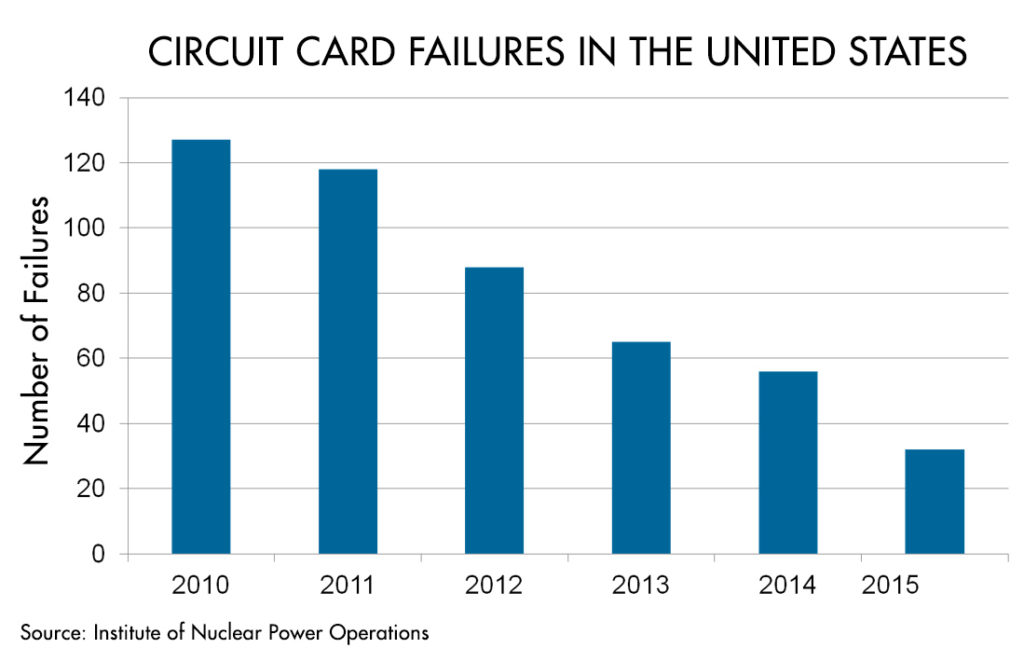EPRI Collaborates with Chinese Nuclear Utility to Transfer Insights from Successful Reliability Program
An EPRI report documents an innovative program at China General Nuclear Power Corporation (CGN) that has significantly reduced the frequency of unplanned reactor shutdowns related to instrumentation and control (I&C) equipment failures. The product of a two-year collaboration between EPRI and CGN, the study offers insights and lessons to nuclear operators worldwide.
I&C equipment serves as a nuclear power plant’s central nervous system, measuring and controlling various parameters for safe, reliable operations. While most printed circuit cards that reside in the equipment continue to work well, the nuclear industry has observed that more circuit cards are failing, leading to unscheduled shutdowns, lost revenue, and other operational problems for power producers.
“Failure rates have increased primarily due to component aging and improper storage and handling,” said EPRI Technical Leader Stephen Lopez.
A New Program to Reduce “Scrams”
Beginning in the late 1990s, CGN plant workers noticed an increased frequency of unplanned shutdowns, or “scrams,” attributable to failing circuit cards and I&C equipment.
“I&C reliability was the main contributor to scrams in our nuclear power plants,” said Ma Shu, a chief engineer with CGN. “We discovered that these issues created 70% to 80% of our unplanned outages, many of which occurred at peak demand.”
To reduce these scrams, CGN developed and implemented an I&C aging management program, with positive results: While there was an average of nearly six unscheduled shutdowns per year in the late 1990s as a result of I&C equipment failures, no such incidents were reported from 2003 to 2013.
The program categorizes components based on how essential they are to reliable operations along with their aging characteristics, then tracks failure rates throughout the life of the equipment. Different strategies are assigned to each category and stage of equipment life to help prioritize testing, monitoring, and maintenance. CGN also developed technical standards and technologies to diagnose degradation and faults in circuit boards and other I&C components, including power supplies, fuses, and relays.
The program’s other key aspects include:
- A database for tracking equipment status, test history, and operating experience
- Monitoring plant environmental conditions, such as temperature, humidity, and radiation
- Preventive maintenance and replacement of critical equipment with spare parts
After CGN joined the Instrumentation and Control Program in EPRI’s Nuclear Sector in 2014, EPRI researchers made a series of visits to China to learn how the program reduced I&C-related reactor and turbine trips and to collaborate on technology transfer.
“The best way to reduce circuit card and circuit card–related I&C failures is to study reliability, develop a program that monitors components and mitigates failures, and then implement and track the program,” said Lopez. “CGN dedicated funding to long-term planning and resource development that supported new laboratory testing facilities and highly qualified staff to operate and manage them. Another strength is CGN’s use of metrics to benchmark the performance of its reliability program against other such programs.”

EPRI has been examining I&C reliability and circuit card issues in nuclear plants for more than a decade. Published in 2010 and updated in 2011, EPRI’s “Gold Card” report provides information on degradation mechanisms and failure risks for I&C circuit cards, along with best practices to prevent failures.
The nuclear industry has used the Gold Card report and other guidance to improve circuit card reliability, as demonstrated by declining circuit card failures reported to the Institute of Nuclear Power Operations (see chart). CGN has used the EPRI guidance to enhance equipment storage, refurbishment, and processes to control electrostatic discharge. As another example, FirstEnergy has applied it to reduce “infant mortality” failure (occurring shortly after components are installed) and to improve its circuit card refurbishment process (see p. 34 in the Winter 2014 issue of EPRI Journal).
“Through the exchange of information and technology, EPRI continues to help address challenges facing the nuclear industry by bringing together its members and diverse scientific and technical communities,” said Lopez.
EPRI Technical Expert:
Stephen Lopez


